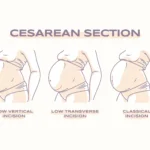
An appendectomy is a surgical procedure to remove the appendix, a small, tube-shaped pouch attached to the large intestine. It is typically performed to treat appendicitis, an inflammation of the appendix that can cause severe abdominal pain and other symptoms. This article will cover the symptoms of appendicitis, the appendectomy procedure, and the recovery process.
Symptoms of Appendicitis
Appendicitis can develop quickly, and recognizing its symptoms is crucial for timely treatment. Common symptoms include:
1. Abdominal Pain
- Location: Pain usually starts around the navel and then moves to the lower right abdomen.
- Intensity: It can range from mild to severe and often worsens with movement, coughing, or deep breaths.
2. Nausea and Vomiting
- Often accompanies abdominal pain and may occur before or after the pain starts.
3. Loss of Appetite
- A sudden and unexplained loss of appetite is a common symptom.
4. Fever
- A low-grade fever may develop as the body responds to the infection.
5. Digestive Issues
- Symptoms like constipation, diarrhea, or an inability to pass gas can also occur.
6. Swelling in the Abdomen
- The abdomen may become swollen and tender to the touch.
If you experience these symptoms, it is essential to seek medical attention promptly. Untreated appendicitis can lead to a ruptured appendix, which can cause a severe and potentially life-threatening infection.
The Appendectomy Procedure
An appendectomy can be performed using two primary methods: open surgery and laparoscopic surgery. The choice of method depends on the patient’s condition and the surgeon’s expertise.
1. Open Appendectomy
- Incision: A single, larger incision is made in the lower right abdomen to access and remove the appendix.
- Procedure: The appendix is removed, and the incision is closed with stitches or staples.
2. Laparoscopic Appendectomy
- Incisions: Several small incisions are made in the abdomen.
- Procedure: A laparoscope (a thin tube with a camera) and surgical instruments are inserted through the incisions. The appendix is removed with the help of the camera, which provides a clear view of the internal organs.
- Advantages: This method usually results in less pain, a shorter hospital stay, and quicker recovery.
Pre-Surgery Preparation
- Medical Evaluation: Before the surgery, a thorough medical evaluation, including blood tests and imaging studies (like an ultrasound or CT scan), will be conducted to confirm the diagnosis.
- Fasting: You will be instructed not to eat or drink for several hours before the surgery.
- Anesthesia Consultation: An anesthesiologist will discuss the type of anesthesia used, usually general anesthesia, which will keep you asleep and pain-free during the procedure.
Post-Surgery Recovery
- Immediate Recovery: After the surgery, you will be taken to a recovery room where medical staff will monitor you as the anesthesia wears off. You may experience grogginess, nausea, or mild pain.
- Pain Management: Pain medications will be provided to manage any post-surgical discomfort. It’s essential to follow the prescribed dosage and schedule.
- Hospital Stay: The length of your hospital stay depends on the type of surgery performed and your overall health. Laparoscopic surgery often requires a shorter stay (1-2 days), while open surgery may require a slightly longer stay (2-3 days).
At-Home Recovery
- Rest: Allow your body to heal by getting plenty of rest. Avoid strenuous activities and heavy lifting for at least a few weeks.
- Wound Care: Keep the surgical site clean and dry. Follow your doctor’s instructions for wound care, including when and how to change dressings.
- Diet: Start with light, easy-to-digest foods as you transition back to your regular diet. Stay hydrated and avoid alcohol and caffeine initially.
- Activity: Gradually increase your activity level as you feel more comfortable. Gentle walking can help prevent blood clots and improve circulation.
- Follow-Up Appointments: Attend all scheduled follow-up appointments to monitor your recovery progress. Your doctor will check the surgical site and address any concerns you may have.
Potential Complications
While appendectomy is generally safe, some complications can arise, including:
- Infection: Signs include increased redness, swelling, or discharge from the incision site, and fever.
- Bleeding: Excessive bleeding at the surgical site or internally.
- Hernia: A bulge at the incision site, particularly with open surgery.
- Bowel Obstruction: Difficulty passing stool or gas, abdominal swelling, and vomiting.
If you experience any of these symptoms, contact your healthcare provider immediately.
Conclusion
An appendectomy is a common and generally safe procedure to treat appendicitis. Recognizing the symptoms of appendicitis and seeking timely medical attention can prevent complications and ensure a smoother recovery. By understanding what to expect and how to prepare, you can approach the procedure with confidence and focus on your recovery.
FAQs
1. How long does it take to recover from an appendectomy?
Recovery time varies, but most people can return to normal activities within 2-4 weeks. Full recovery may take longer if complications arise.
2. Can you live without an appendix?
Yes, you can live without an appendix. The appendix does not perform any essential functions in the body.
3. What are the signs of infection after an appendectomy?
Signs of infection include increased redness, swelling, or discharge from the incision site, fever, and persistent pain.
4. Is it normal to have pain after an appendectomy?
Some pain and discomfort are normal after surgery. Pain should gradually decrease over time. If pain persists or worsens, contact your healthcare provider.
Understanding the appendectomy process and following your doctor’s advice can lead to a successful recovery and a return to normal life activities.

